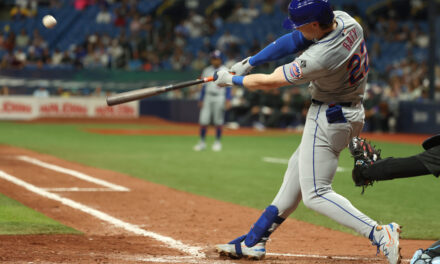
“In our situation, short term, pitching is everything.”
That was Met GM Sandy Alderson talking with the press early in the week. No one could argue Alderson’s point. Battle weary Met fans understand their team is still blessed with starting pitching riches. But, after the epic 2017 starting pitching collapse, the 2018 spring training outlook of the Met faithful is leery, an outlook that’s hopeful at its core but enveloped in an outer crust of caution, sometimes even skepticism. Fool me once, shame on you. Fool me twice, shame on me.
Regardless of the edginess of Met fans, like the start of the 2017 season, the Mets have more starting pitching arms than available rotation spots. Citing extra off days added to the schedule this season, Met manager Mickey Callaway doused any thought of a six man rotation. Should somehow the eight guys vying for five rotation spots stay healthy by Opening Day, Callaway has some decisions to make putting together his starting rotation.
I’ve enjoyed the out of the box thinking Callaway has brought to the Mets’ camp this spring. It feels like Callaway is adding some pages to the baseball book that has governed the way old time skippers have managed the game for so long. Whether it’s analytics, an active and creative mind, or just good old common sense, Callaway seems open to all kinds of ideas that might improve his team’s performance on the baseball diamond.
With that spirit of possibility in place how about a six pitcher cadre in a five man rotation? Everyone knows that Jacob deGrom and Noah Syndergaard are the anchors of the Met rotation no matter who is selected to follow. And, it’s unlikely the Mets expended the kind of money they did on Jason Vargas without providing him every opportunity and more to be a mainstay in Callaway’s rotation. And, more and more, it’s appearing like Matt Harvey is positioning himself to latch on to the fourth rotation slot. That leaves four pitchers plausibly in competition for the final rotation spot.
I entertain the idea of using Zack Wheeler and Steven Matz to share that fifth and final slot. Share a pitching rotation spot? Lunacy, baseball thinkers in the box might suggest, loudly I might assume. But, when you get past the original reaction, the idea might have some merit.
For starters, both Wheeler and Matz see themselves as starters. That’s more important than some might believe. Psychologists have long believed that a person’s actions reflect the person you think you are. It’s not the words that come out of your mouth that determine the course of your life but the words you whisper to yourself. In the cases of Wheeler and Matz, both their spoken words, and I’d wager their private thoughts, all reaffirm their belief they are starting pitchers.

And, in some ways that same sentiment is shared by Met brass. We’ve read the Mets are nervous about the prospect of using either Wheeler, and especially Matz, in relief because of their injury laden past. Both pitchers have been groomed to expect a long warm-up period prior to their pitching starts. The short warm-up and up and down nature of working out of the pen might not fare favorably to oft injured starters. If Wheeler and Matz shared a rotation slot with one staring and targeted to pitch the first 5 innings, and the other coming on and targeted to pitch the final four, and with the pitcher’s alternating starts and finishes, both would benefit with extended time readying to pitch whether they were slated to start or to finish a game.
Then there is the question, should they stay healthy, of how many total innings the Mets will be willing to allow Wheeler or Matz to amass this season. It seems almost certain that with their injury history, the team will place restrictions or inning caps on both pitchers. I doubt that whichever pitcher wins the final rotation spot in the traditional alignment would be allowed to throw much more than 140 to 150 innings.
Sharing starts, even in the best of circumstances, an estimate of average innings per outing would would max out at 4.5. Over 30 starts throughout the course of a season that would come to roughly 145 innings apiece. No Met fan, and certainly not Wheeler or Matz, wants either pitcher to be closed down before the regular season ends, especially if the Mets were in a playoff chase.
From a game strategy perspective, this out of the box rotation idea might also have pay value. Both Wheeler and Matz have histories of struggling early in a game. Should that be the case. Calloway would have another option to go to with a faster hook before taxing his regular bullpen. And, in the rare cases where the combined pair piece together a solid 9 inning outing, the combined effort would provide a day off for the entire Met bullpen, reminiscent of the golden days when guys like Seaver and Koosman hurled complete games without needing bullpen help. In a day and age of starting pitchers going just 6 or 7 innings an off day for the entire bullpen is a precious rarity.
Even more important, should either Wheeler or Matz experience injury, the other pitcher would be stretched out, ready and hopefully able to turn in five or six inning starts using the more old-fashioned traditional rotational alignment we’re used to.
The two starters for one rotation spot scenario would move Robert Gsellman to the bullpen. Of the four starting pitchers, I believe Gsellman has the best pitching repertoire to transition to work effectively out of the pen. And, Seth Lugo, still with options, and pitching with a partially torn collateral injury, could head to Vegas to stretch out as a much needed starting pitching insurance plan.
Two starting pitchers to fill one rotation spot? Why not think out of the box? This is quite common in the lower levels of the minors. Once you get over the original gasp and wrap your head around the thought, it might just have some promise.














